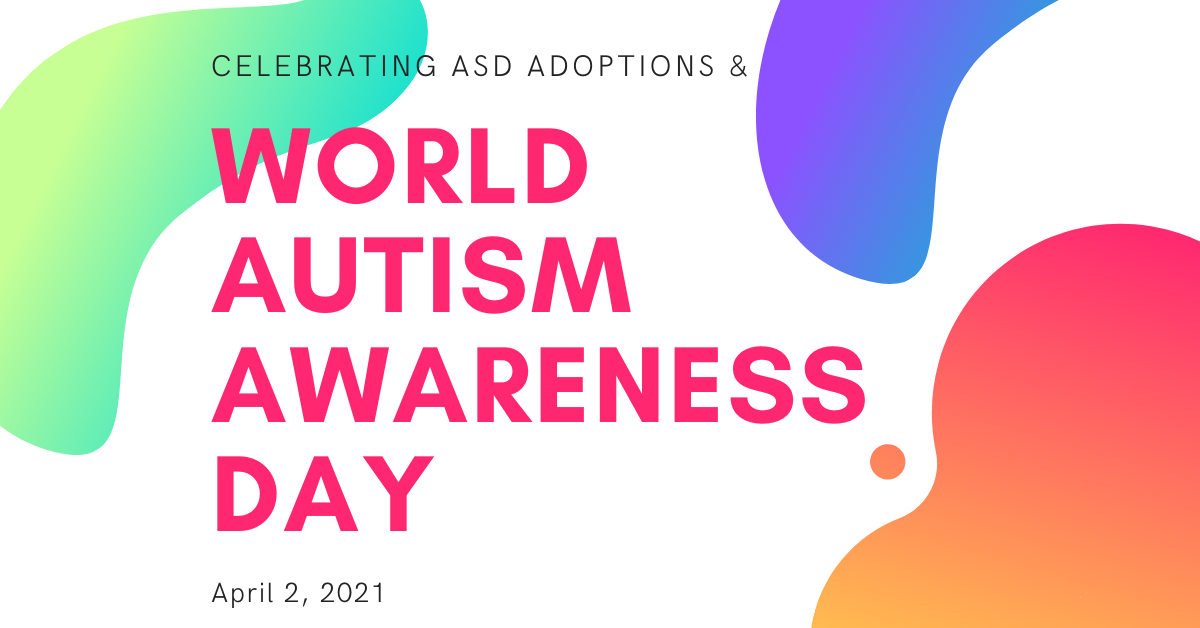Celebrating ASD Adoptions & World Autism Awareness Day

April 2nd is designated as World Autism Awareness Day, and it’s the perfect time to provide a few helpful tips to those who have adopted or are considering adopting a child with Autism Spectrum Disorder (ASD).
Did You know?
The Center for Disease Control and Prevention (CDC) states that the prevalence of autism rose from 1 in 125 in 2004 to 1 in 54 in 2016. It’s important to note that children with ASD are more likely to end up in the foster care system.
This environment of unpredictability and change is quite scary for any child, especially for ASD children. How can parents help their child adapt comfortably to a new home environment? Below are a few tips to help with the transition:
Create Consistency
And no, we don’t mean that you must become like Bill Murray’s character Phil Connors, forever stuck in a loop on Groundhog’s Day. However, developing a daily routine is an integral part of every child’s growth and happiness. This is especially crucial for foster and adopted children with ASD. Predictability of daily routines can set your child up for success.
A Few Suggestions from Parents of Children with ASD:
- Allow older children to be a part of creating their routine. Sit down with them and ask what routines they‘ve had in place in the past. Reinstating old tasks in a new place can be a source of comfort for them.
- Write down daily routines on a piece of paper where the child can see them. If the child cannot read, draw or take pictures of them completing each step and post the images on the wall for reference. For example, a morning routine could include pictures of them eating breakfast, brushing their teeth, and grabbing their backpack for school.
- A soft-sounding timer or a visual alarm is a useful cue to begin each daily task. When each step is complete, don’t forget to provide task-specific, positive praise.
- Consistency is key! Regular habits and schedules help children with ASD feel connected and safe.

Build Trust and Respect
Aretha Franklin was completely right when she sang “R-E-S-P-E-C-T, find out what it means to me.” Learning to build an adopted child’s trust and earn their respect is all about learning their personality. This is especially true for children with ASD who often fixate on special interests. Does your child love facts about sharks? Ask them for a new fact each day! Do they love to draw? Have a special space to post their picture of the week. Become engaged and supportive in their interests and do your best to communicate with them in a way they understand.
Oftentimes, children with ASD are literal. Building trust means communicating with them effectively. Sarcasm and jokes often end in confusion and hurt feelings with an ASD child. Learn your child’s way of communicating and expressing their emotions and mimic it. If they are nonverbal, this blog on autismspeaks.org is a great resource for creative ways to communicate with your child.
Patience, Patience, Patience
We’ve all seen the Disney cartoons where Donald Duck’s short-fuse is displayed through his red face rising like a temperature gauge about to burst. By that point, we all know that poor Donald is stressed out because things aren’t going his way. But how do we, as parents, make sure our gauge never reaches those limits?
It’s simple. Start with empathy, not anger. Many adopted ASD children have had to deal with a huge amount of trauma in their lives. Stop and think about the escalating situation and breathe deeply. Ask yourself what you can do to help de-escalate the moment. The most important thing you can do for your child is to remain calm. They look to you as the prime example of how to behave.
If a difficult task is the source of the meltdown, help break down the big obstacle into smaller, more manageable pieces. Always remember, patience and love will go a long way in building a supportive, trust-filled environment for your child.
Self-Care is Essential
There’s a reason why flight attendants always caution passengers to secure their own oxygen masks before assisting others. The concept is simple. If you don’t take the time to care for yourself, you won’t be in any shape to help others. The same concept applies when adopting a special needs child. Take a break to enjoy the simple things.
Below are some ways to relax and indulge in self-care:
- Set aside time each day to do the things you enjoy.
- Surround yourself with supportive family and friends.
- Join a Support Group and interact with them regularly.
- Keep a journal and jot down the positive points in your day or moments that made you laugh or smile.
Know Your Resources
Adopting a child with ASD is a truly wonderful experience. It’s important to know that you are not alone in your journey and there are many resources available to you and your family.
Interested in adopting? Our Hearts to Home (Adoption from Foster Care) Program is designed for families seeking to adopt a child through the foster care system and provides supportive resources and services unique to foster adoption. Serving children ages 3-18 in the child welfare system, Heart of Adoptions Alliance, Inc identifies families best suited to embrace and manage the specialized needs for Florida’s waiting children. The process- from navigation to placement, to counseling and coaching- helps to promote success and ultimate well-being for the child and the family.
We typically hold monthly information nights, which covers the Hearts to Home program and provides information regarding the process, fees, services offered, etc. In addition to attending an information night, we also ask that the families interested in this program have a one-on-one meeting with a representative from the program. Please sign up for your information night session here.
Click here to contact a program representative.
*We recognize that all children with ASD have unique needs and personalities. This blog is not intended to be a one-size-fits-all solution, rather an idea generator implemented at the reader’s own discretion. The above tips and suggestions are not provided or reviewed by a medical doctor, and it is always wise to consult a physician before implementing any strategy or advice you read online.










One Response
Comments are closed.